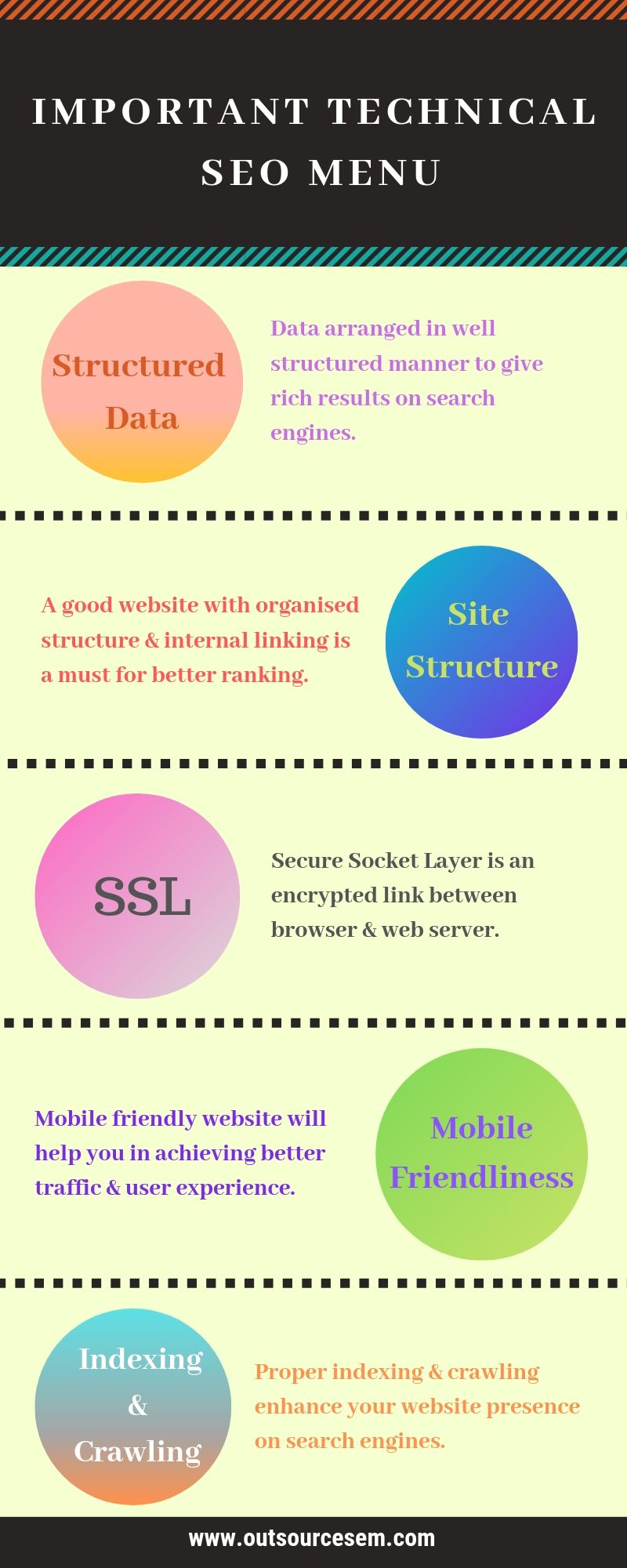Before getting in-depth understanding of technical SEO and how you can master them? Let us first clarify about SEO & technical SEO.
SEO: Search engine optimisation is the process of optimising your website for search engines. It covers all the area of website SEO. After optimisation, your website becomes user friendly, rank better & drive more traffic.
Technical SEO: Don’t get feared of the term technical used here. Technical SEO simply means covering website SEO (search engine optimization) other than its content section. In this, we focus on crawling & indexing factors and optimise them accordingly.
Let us now move to our discussion topic “How to ace technical SEO”. To master it, you should have knowledge of some important terms associated with it & how to use it to get tremendous results.
Important Technical SEO Menu:
• Structured Data
• Site Structure
• SSL
• Mobile Friendliness
• Website Indexing & Crawling

1. Structured Data: Now-a-days rich results have becomes trending. People often wants to have every information of a particular search on very first page without even clicking on it. Further, if they click on the link they wish to have every information in rich formats such as with image, video, reviews & ratings snippets. To get rich results for your website, you need to implement structured data. As it will help web crawlers to better understand your content categories & subcategories. Also, you have to keep in mind that after implementing structured data you are not going to see the results instantly. It will take sometimes. But, once you achieve that you will definitely see huge rise in traffic. You will be surprised to know that there are almost 30 different types of rich results powered by schema. Now, you might be wandering how & where to implement structured data. To make it simple, follow these below mentioned steps.
Steps:
• Visit schema.org & select suitable schemas from list which will suits your content best. After that, assign these schemas to URLs.
• After that, you need to generate mark-ups which don’t require pro skills.
• To do so, apply Google’s structured data mark-up helper to get complete process done step by step.
• Thereafter, you should do testing of mark-ups using rich result testing tool.
• Always remember that Google supports it in three formats: Microdata, RDFa & JSON-LD. Among three, JSON-LD is the most preferred one.
2. Site Structure: A well-developed site structure may put up your website to higher rankings. You can see on search engines that websites of any kind have some type of structure. It may be sequence-wise or unorganised. Intuitive design can always help users to navigate easily. It becomes easier for bots to access all the pages of your website quickly if architecture is up to the mark. To get better search relevancy, you should keep focusing on site structure & how you can make it much better? Let us try to understand some techniques which can help you to solve your site structure issue if you don’t have a good one.
Below mentioned points are needed to be focus more for an efficient site structure.
Internal Link Structure:
We all know the importance of external links or backlinks but do you ever thought how effective internal linking can be for your site? Linking different page internally will be very much beneficial as linking cause thorough spread of link juice between all the pages which in turn gives boost in traffic to pages which have less DA. But, make sure to do interlinking between related content only to get better outcomes.
Some useful tips:
• Pages with 3 clicks away from homepage will be much benefited. For a large website, breadcrumbs are recommended.
• Also, we have discussed above linking to a related content should be always preferred because these links have more weighs to SEO than any other navigational ones.
• Lastly, always try to insert keywords in anchor text. So that it will easily create attention of readers and they can have related information as well. You can also use same process for image attributes.
Sitemap:
Sitemap enables search engines to detect and find your website. Furthermore, it will read site structure & come up with fresh content. These site maps are generally list of web pages of a particular website. Mainly there are three category of site map that are listed below:
• Structured listed for web crawlers
• Listings that are human visible
• Site maps used during initial days of planning of a website.
For any reason if you lack sitemap or don’t have one. Then, hurry up and create one & upload it to google search console. Using W3C validator, sitemap coding can be evaluated whether it’s done properly or not.
Tips:
• Make it concise
• Make it clean i.e. free from errors, blocked resources
• Whenever you make some changes, keep it updated.
3. SSL: It stands for ‘Secure Socket Layer’ which is a standardised technology used for security purpose for establishing an encrypted link between a browser & a web server. Encryption will help here in transfer of data in integral, private & secure way. It comes with industry standard norms & used by many websites for protecting their online transaction. Few years back, Google announces that websites must be HTTPS secure. Also, from then Google will be going to give priority to HTTPS secure website over non-HTTPS website.
4. Mobile Friendliness: In present scenario, use of mobile devices for search queries have been grown exponentially. Users prefer to use their mobile often for searching anything online. Hence, making your website mobile-friendly is not an optional, it’s a must. After the introduction of Mobile-first indexing by Google, it starts crawling your website with respect to mobile point. It means if your website is not a mobile friendly then your website ranking will suffer and further, it will lower the rank.
If crawler don’t find your website for mobile compatibility, then it will still index for desktop devices. Mobile indexing will help to see how your website going to rank over mobile and desktop devices simultaneously. It’s a part of technical SEO audit, you don’t have to bother much to make your website mobile friendly. Just have a mobile friendly theme that is configured properly and later you don’t have to struggle anymore. You might be thinking now; what steps should I take to make my website friendly? To do so, just follow the below mentioned tips:
• Mobile website must load within 6 seconds
• Content should be same for both the mobile and desktop versions. As Google mobile index rank mobile website according to their content. So, it should be similar to that of desktop one
• You might face lower conversions on mobile but still you should not avoid it. Rather than that, optimize your website for mobile devices regularly.
• Popups should be avoided
• Also, you should always remember that AMP (Accelerated Mobile Pages) won’t replace completely the need of mobile website. So, if you have chosen AMP then you still require mobile friendly website.
Note: If you have responsive and fast website, then don’t get nervous about mobile first index. Also, if there is a different mobile website on a subdomain, then it should have similar content to that of desktop devices as we have discussed above.
5. Website Indexing & Crawling: Last but one of the most important is website indexing and crawlability for technical SEO. You want to be sure that search engines are properly indexing your website. It’s easy to monitor that, to do so simply visit Google search console and you can see the total number of web pages that are being indexed by search engines. Type site:domain.com in search bar and get the result or you can use SEO crawler i.e. website auditor for SEO audit purpose. Furthermore, Google has ability to index all types of resources which may be HTML, CSS & JavaScript. Hence, if some pages are blocked, it won’t see the pages in the way it should look and will not render it well. During index process, you will see various results related to your web pages. One such is orphan pages. Those pages which are available on your website but aren’t linked with any other pages i.e. they’ll become invisible for search engines. Always make sure to be safe from orphan pages. Also, you will see paginated content during indexing process. It states that you must have single page content rather than using rel=next, rel=prev as it does not support it now.
What you can do to have proper index?
• You should check your robots.txt file to see that your important pages haven’t get blocked.
• Always cross check your website crawling by using tool that can render and crawl properly.
Conclusion:
Finally, we have come to an end of this topic. We had discussed so many things about technical SEO which will help you further to pace up your website SEO. So far, we studied about its important factors and what more improvements can be done to give you best possible results. Here, we mainly focussed about structured data, site structure, SSL, mobile friendliness and website indexing & crawling.
All these play a key role in making technical SEO work smoothly for your website. So, follow the above mentioned steps and make your website rank high along with good amount of traffic. Also by hiring digital marketing experts from a digital marketing company you can take out SEO report, analyse SEO, have a proper backlink analysis, get copywriting services, etc for your client
#References
• The Beginner’s Guide to Technical SEO
• How to master technical SEO: Six areas to attack now
